The following Cut Parameters tab allows you to define the cut parameters for the current 3 Axis Spiral Machining operation. You can set Global Parameters, Cut Pattern, Spiral Parameters and Stepover Control via this tab of the operation dialog. The Global Parameters section allows you to set the tolerance value to be used in machining. A uniform thickness or stock that needs to be left around the part can also be specified here. Refer to each option below.
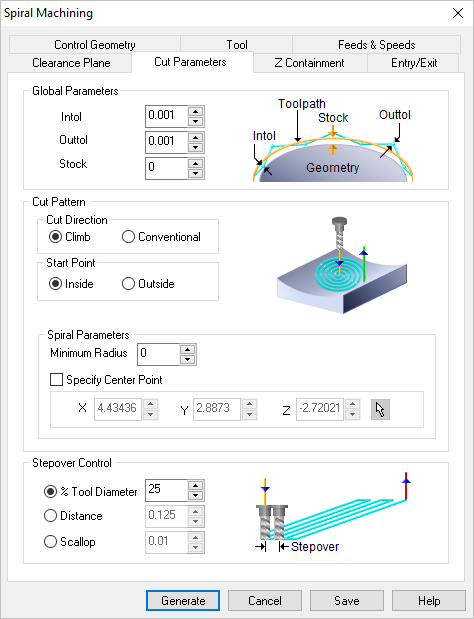 Dialog Box: Cut Parameters tab, Spiral Machining, 3 Axis |
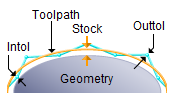 Global Parameters, 3 Axis Operations The Global Parameters section allows you to set the tolerance value to be used in machining. Intol and Outol are allowable deviations (tolerances) from the actual part geometry plus the Stock layer (if any). A uniform thickness or stock that needs to be left around the part can be specified here.
Intol / Outol
Inward tolerance - the maximum thickness of material that can be removed from the Stock layer. Outward tolerance is the maximum thickness of material that can remain above the Stock layer.
 Tolerances play a vital role in both design engineering and digital manufacturing. In design, the goal is to allow the broadest tolerance range possible while meeting your design specifications. This is because, generally speaking, there is a direct correlation between tighter tolerances and higher manufacturing costs. Tolerances play a vital role in both design engineering and digital manufacturing. In design, the goal is to allow the broadest tolerance range possible while meeting your design specifications. This is because, generally speaking, there is a direct correlation between tighter tolerances and higher manufacturing costs.
Read the full article...
|
|
Stock
The thickness of the layer that will remain on top of the part after the toolpath is complete. Roughing operations generally leave a thin layer of stock, but for finishing operations this value is zero.
|
This section allows you to define the type of cut pattern that the tool will follow.
•Cut Direction
You can control the Cut Direction as either Climb or Conventional. If you choose the Climb operation the toolpath is generated in the counter-clockwise direction. If the Conventional mode is chosen, machining will start at the same point but in the clockwise direction.
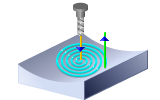 Climb |
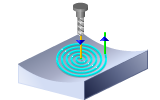 Conventional |
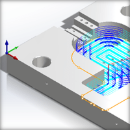 One of the basic concepts to understand in any milling operation is Cut Direction. It can be characterized by how the flutes of the cutting tool engage the stock material and form the chip that is removed during cutting. In many of MecSoft CAM’s 2½ & 3 Axis toolpath strategies you will see that Cut Direction is defined by selecting one of three options, Climb, Conventional or Mixed. Let’s take a look at the characteristics of each option. One of the basic concepts to understand in any milling operation is Cut Direction. It can be characterized by how the flutes of the cutting tool engage the stock material and form the chip that is removed during cutting. In many of MecSoft CAM’s 2½ & 3 Axis toolpath strategies you will see that Cut Direction is defined by selecting one of three options, Climb, Conventional or Mixed. Let’s take a look at the characteristics of each option.
Read the full article...
|
|
•Start Point
The Cut Pattern allows you to define the Start Point of the toolpath. The two available options are: Inside or Outside the selected region. Selecting the Inside option causes the toolpath start point to be the centroid of the selected region. Selecting the Outside option causes the start point of the toolpath to be on the largest circle with the centroid as the center.
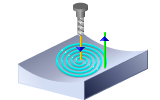 Inside |
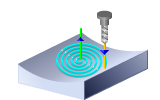 Outside |
|
•Minimum Radius
This section allows you to specify the Minimum Radius for the Spiral Machining toolpath.
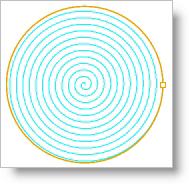 Minimum Radius = 0 |
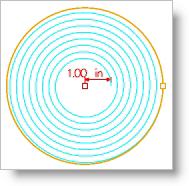 Minimum Radius = 1 |
•Specify Center Point
You can specify a valid coordinate point for the center of the toolpath or use the Pick  option to pick a point to determine the center. option to pick a point to determine the center. |
 Stepover Control, 3 Axis Operations This allows you to define the spacing between the cuts. Select from the following options:
% Tool Diameter
Enter the stepover distance as a percentage value of the tool diameter.
Distance
Enter the exact stepover distance preferred.
Scallop
(not available for all operations)
Enter the scallop height to determine the spacing between cuts.
|






 One of the basic concepts to understand in any milling operation is
One of the basic concepts to understand in any milling operation is 


